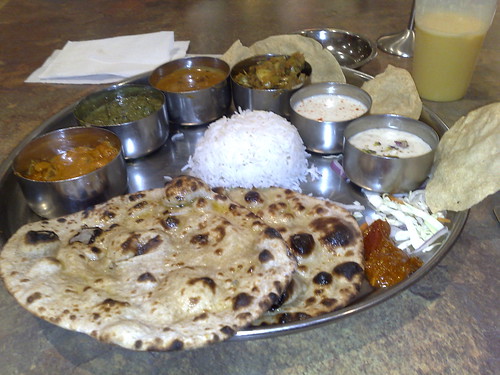
Punjabi cuisine (from the Punjab region of Northern India) is mainly based upon Wheat, Masalas (spice), pure desi ghee (Clarified butter), with liberal amounts of butter and cream. Though wheat varieties form their staple food, Punjabis do cook rice on special occasions. During winter a delicacy, Kheer a very popular dessert is cooked using rice.
Punjabi cuisine specializes in variety and it can be non-vegetarian or completely vegetarian. It is widely popular however there is some ignorance in Western Cultures that Punjabi is cuisine is completely curry based. The level of spices can vary from minimal to very prevalent. One of the main features of Punjabi cuisine is its diverse range of dishes. Home cooked and restaurant Punjabi cuisine can vary significantly, with restaurant style using large amounts of clarified butter, known locally as desi ghee, with liberal amounts of butter and cream with home cooked concentrating on mainly upon wheat masalas (spice) flavorings. Though wheat varieties form their staple food, Punjabis do cook rice on special occasions. During winter a delicacy, Roh Di Kheer, is cooked using rice. Rice is cooked for a long time in sugar cane juice.Within the state itself, there are different preferences. People in the area of Amritsar prefer stuffed parathas and milk products. In fact, the area is well known for quality of its milk products. There are certain dishes which are exclusive to Punjab, such as Mah Di Dal and Saron Da Saag (Sarson Ka Saag).
The food is tailor-made for the Punjabi lifestyle in which most of the rural folk burn up a lot of calories while working in the fields. The main masala in a Punjabi dish consists of onion, garlic and ginger. Tandoori food is a Punjabi speciality especially for non-veg dishes.
Zealous people from the state of Punjab are not behind any other state of the country when it comes to food. Their infectious zest of food has caught millions others, so much so that the Punjabi cuisine is not just relished in India but the world over. Foreigners often identify Indian cuisine with Punjabi food thanks to the the big Punjabi diaspora and the mouth-watering cuisine of the state.
Staple diet of the people Punjab and Haryana is wheat based rotis, paranthas and naan. Rice is cooked less frequently on special occasion. It is often prepared flavoured with onions and other condiments. Striking feature of the cuisine of Punjab is lavish use of butter, cream, ghee and cheese. Pulses or dals , cooked on slow fire and flavoured with characteristic Punjabi tadka, constitute a major item of the meal. Gravy is prepared using the basic mix of onion, tomato, ginger, garlic, chillies and liberal dose of spices. Jaggery is appreciated by the people in the winter season.
Traditional Punjabi food is cooked in earthen tandoors (ovens) which lend it a unique aroma. Though vegetarian dishes of the state are extremely popular and demand no introduction, some non-vegetarian dishes of the state are also famous for their scrumptious taste and the typical Punjabi flavor. The rich food is downed with the famous Punjab-di-Lassi.
Due to proximity and similar crop pattern, food habits of Punjab and Haryana are more or less the same. What distinguishes Haryana a little from Punjab is its greater love for milk and dairy products.
Introduction:
Mention Punjab and the first image that comes to mind is that of lush green fields. Mention Punjabi food and the first thing that comes to mind is makke ki roti and sarson ka saag. Punjabi cuisine is like the Punjabis themselves. It is simple, sizeable and hearty - with no unnecessary frills or exotic accompaniments .
ABOUT THE STATE :
The land of Punjab is a land of earthy culture, myriad images of swaying emerald green fields and warm people whose robust rustic ways of camaraderie and bonhomie are very much a part of their heritage. Beyond its joyous people and carpet spreads of fertile fields, this 'Land of Milk and Honey' has a host of culinary treasures that it readily offers to the others too.
INFLUENCES:
Punjab has imbibed some aspects of its cuisine from external influences. Connoisseurs of the cuisine say that the gravy component of Punjabi cuisine came from the Mughals. The most popular example is the murg makhani. It served the state well to combine this influence in its cooking since it had a lot of pure ghee and butter. Murg makhani also provided a balance to tandoori chicken, which was dry because it was charcoal cooked.
STAPLE FOOD:
Wheat and maize are the staple food grains that the hardworking, food-loving people of Punjab depend on for their nourishment. Typical Punjabi cuisine is as simple as it can get and there is nothing subtle about it. All lentils, especially black gram and yellow gram, are a part of Punjabi cuisine and so are rotis and curd. In fact, if you are anywhere in the north, chances are that you have some Punjabi dish every day without even knowing about it-if it is not dal and roti, then it can be rajma or chana. Milk is synonymous with this land of five rivers and plays an important role in the Punjabi diet. Various milk products add to the variety and a part of the daily diet are milk products like dahi, lassi, paneer, cream and not to miss ghee and butter. Butter is also an important cooking medium apart from being consumed raw along with the food. No Punjabi meal is complete without a blob of white butter (makhan). In Punjabi food, coriander, cumin, cloves, cinnamon, cardamom, black pepper, red chili powder, turmeric and mustard are regularly used. In fact, one of their main crops is mustard or sarson-its leaves used to make sarson-ka-saag while its seeds are used for tempering and also for making mustard oil, which is widely used in Punjabi cuisine.
Non-vegetarian food, especially chicken, is a favorite all over Punjab and the ever-popular tandoori chicken is almost an institution. Mutton and fish are also cooked in the traditional Punjabi kitchens with a lot of enthusiasm and form an integral part of any special menu.
Non-vegetarian food, especially chicken, is a favorite all over Punjab and the ever-popular tandoori chicken is almost an institution. Mutton and fish are also cooked in the traditional Punjabi kitchens with a lot of enthusiasm and form an integral part of any special menu.
METHODS:
Punjabi food is wholesome and full of rustic flavor. The custom of cooking in community ovens or tandoors prevails in rural areas even today. Tandoori dishes are popular all over the country today. Nans and parathas, rotis made of maize flour (makke di roti) are typical Punjabi breads. Of course, over the years the roti has been modified to add more variety, so there is the rumali roti, the naan and the laccha parathas, all cooked in the tandoor.
In Punjabi homes makke di roti and sarson ka saag is something of a delicacy simply because of the time it takes to prepare the dish. Besides the long preparation time, these vitamin rich dishes also require a lot of time to cook. Almost all the preparations are cooked on a slow fire to coax out that perfectly robust taste. Sarson ka saag is cooked on a slow fire for hours with a minimum of spices so that the fresh taste can be retained. In fact, the longer it takes to cook the saag, the better it tastes.
The dals are a specialty of Punjabi cuisine. Made of whole pulses like black gram, green gram and Bengal gram, they are cooked on a slow fire, often simmered for hours till they turn creamy and then are flavored with spices and rounded off with malai for that rich finish. The basic gravy used for vegetables and meat dishes is onion-tomato-garlic-ginger.
SPECIALITIES:
Most Punjabi menus are made according to the season. The universal favorite is chole-bathure which is a round-the-year item and is available at every wayside dhaba anywhere in Northern India. But, the pride of the Punjabi winter cuisine is sarson-ka-saag (mustard leaves) served with blobs of white butter accompanied by makke-di-roti and lassi (churned yogurt).
The other popular dishes, which belong exclusively to Punjab, are mah ki dal, rajma (kidney beans) and stuffed parathas. Punjabi cuisine is characterized by a profusion of dairy products in the form of malai (cream), paneer (cottage cheese) and curds.
Though chicken is a favorite with non-vegetarians, fish is also considered a delicacy, especially in the Amritsar region, which is also known for its kulcha, baked bread made of refined flour.
Tall glasses of lassi, made of yogurt, tempered with either salt or sugar, is a popular cooling drink of Punjabi origin but it is quite popular all over the country. Phirni, a sweet dish made of milk, rice flour and sugar and chilled in earthenware bowls is a typical Punjabi dessert. Punjabi sweet dishes like gulab jamuns and burfi have a strong percentage of khoya again made from milk.
Then there is also paneer-a must in the vegetarian Punjabi menu. Several delectable items are made out of this rather bland derivative of milk. Creations like the Kadai Paneer, and Makhani Paneer are basically Punjabi but are well loved all over the country.
One thing that makes Punjabi cuisine so special is the tandoor. Besides being a versatile kitchen equipment it is much more - a social institution. In rural Punjab, the community tandoor, dug in the ground, is a meeting place, just like the village well, for the women folk, who bring the kneaded atta (dough) and sometimes marinated meats to have them cooked while chit-chatting. Until a few years ago, this phenomenon existed in urban neighborhoods too. Even today, a few neighborhoods have a communal tandoor.
Punjab's other grand contribution is the dhaba - the roadside eatery that has become a prominent feature on the national and state highways. Earlier frequented only by truck drivers, today it is in vogue to eat at a dhaba-urban or roadside.
SPECIAL OCCASIONS:
A predominantly wheat eating people, the Punjabis cook rice only on special occasions. Rice is rarely cooked plain or steamed and is always made with a flavoring of cumin or fried onions, which is the served with rajma (kidney beans) or kadhi (curd curry). In winter, rice is cooked with jaggery - gurwala chawal or with green peas or as a delicacy called Rao ki kheer, which is rice cooked on a slow fire for hours together with sugar cane juice.
HOW TO EAT WHAT:
To go with their fine cuisine, the Punjabi's follow a very simple code of eating. A meal of vegetables and lentils is eaten with phulka or tandoor parathas (wheat bread) spread with desi-ghee or butter. On the other hand, a meat delicacy is usually eaten with a plain phulka or tandoor roti (without ghee or butter), accompanied by nothing more than a raita and muthi-piaz (onions split open by smashing them with a fist).
Punjabis believe in eating out of a big brass thali using their fingers and drinking out of a 12-inch-long brass glass.
EATING OUT:
In cities all over India, especially Delhi, Punjabi cuisine has got more complex with specialized restaurants surfacing all over. While some call themselves specialists in seek kebabs and rumali rotis others claim to serve only authentic butter chicken and chana masala. Even five star hotels have joined the bandwagon with their specialty restaurants recreating the ambience of a typical Punjabi Dhaba.











Post a Comment